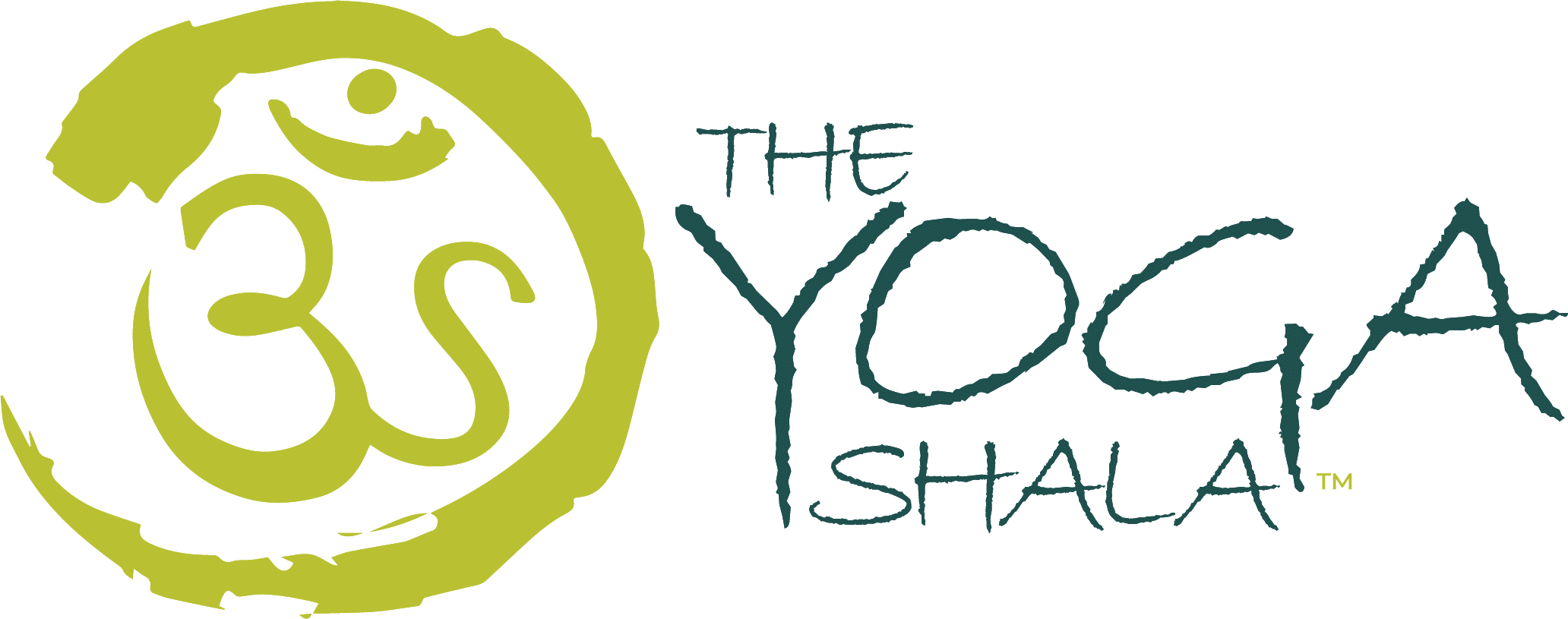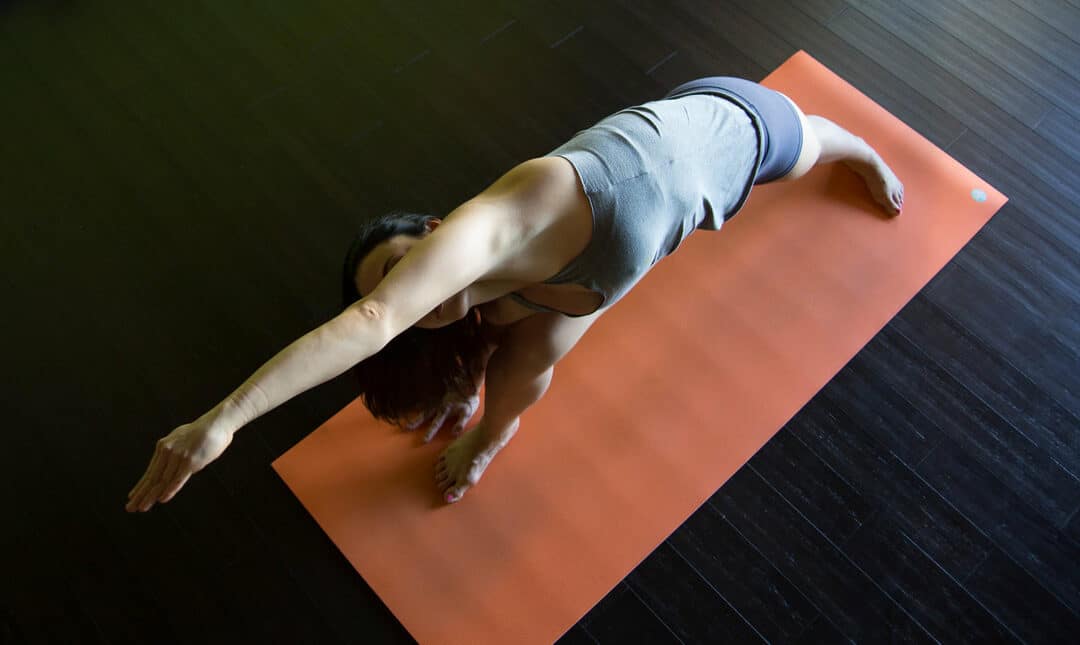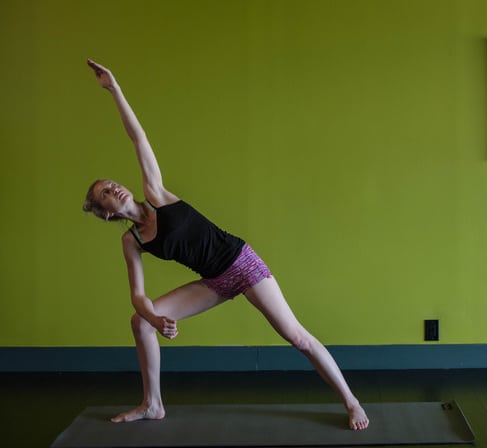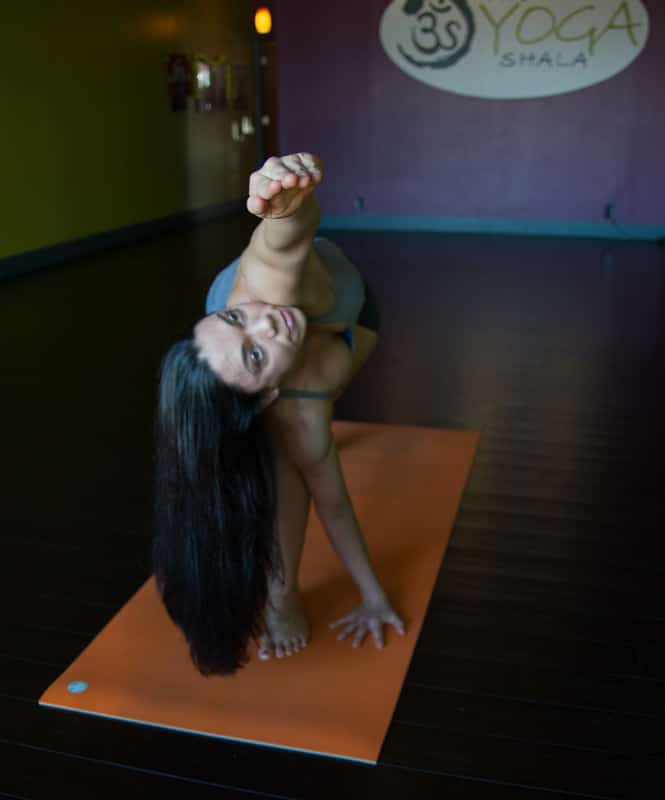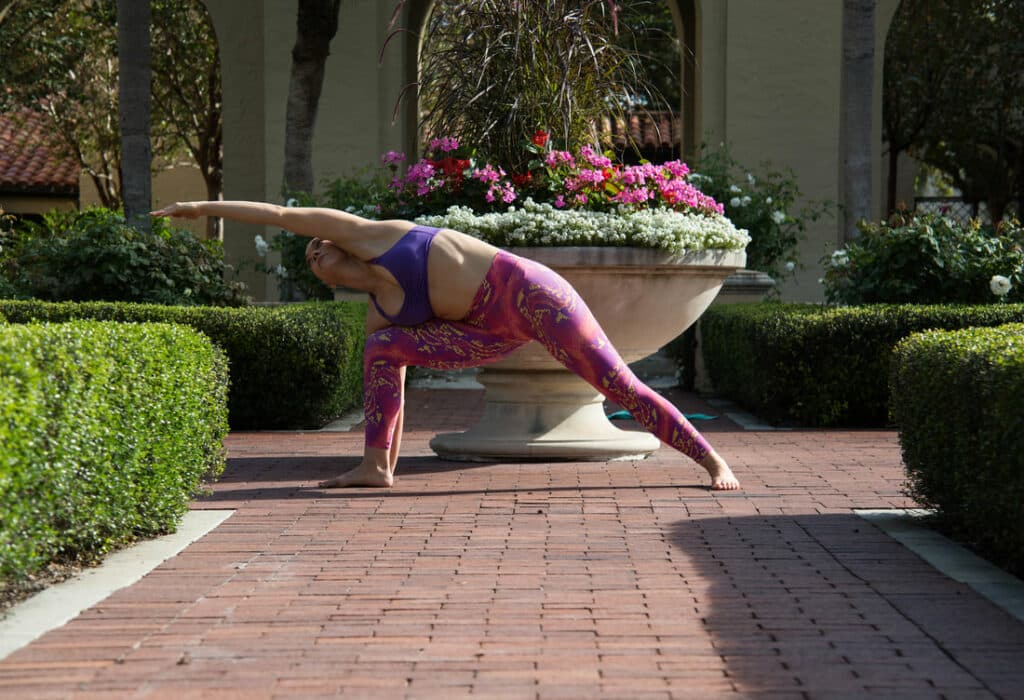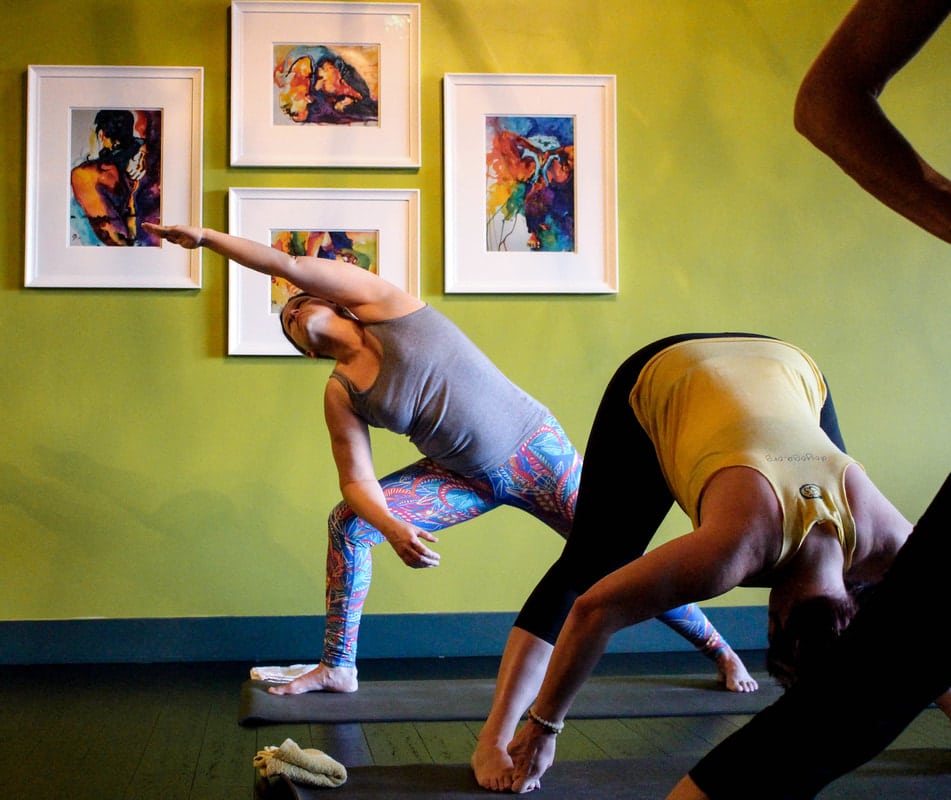Ashtanga yoga, a dynamic and powerful form of yoga, comprises a series of postures that are synchronized with breath and movement. Among the many postures in the Ashtanga Primary Series, Utthita Parsva Konasana and Parivrtta Parsva Konasana are two challenging and invigorating poses that offer numerous benefits for the body, mind, and spirit.
Utthita Trikonasana translates to Extended Side Angle Pose and Parivrtta Trikonasana, Revolved Extended Side Angle Pose. These postures are the fifth and sixth poses of the Ashtanga Yoga Primary series. They come after Utthita Trikonasana and Parivrtta Trikonasana.
Tap here to watch a step-by-step tutorial video on 2 modifications and the full expression of Utthita Parsva Konasana and Parivrtta Parsva Konasana.
BENEFITS
Utthita Parsva Konasana and Parivrtta Parsva Konasana are two yoga poses that offer numerous benefits to the body, mind, and spirit. Both poses are variations of the wide-legged standing forward fold pose, and they involve stretching and twisting movements that provide unique advantages. Let’s explore the benefits of each pose in more detail:
Utthita Parsva Konasana (Extended Side Angle Pose):
Stretches the hips and groin:
Utthita Parsva Konasana involves a deep stretch in the hips and groin area, which can help to release tension and tightness in these areas. It is particularly beneficial for individuals who sit for long periods or have tight hip muscles due to various activities.
Strengthens the legs and core:
This pose engages the muscles in the legs, including the quadriceps, hamstrings, and calves, helping to tone and strengthen these muscles. The pose also activates the core muscles, including the abdominal muscles and obliques, which can help to improve stability and balance.
Opens the chest and shoulders:
Utthita Parsva Konasana involves extending one arm towards the ground and the other arm towards the ceiling, which helps to open the chest and shoulders. This can be beneficial for individuals who sit hunched over a desk or have poor posture, as it can help to counteract rounded shoulders and improve upper body mobility.
Enhances digestion:
The twist involved in Utthita Parsva Konasana stimulates the digestive organs, including the stomach and intestines, which can aid in digestion and improve gut health. It may also help to relieve symptoms of bloating and constipation.
Calms the mind:
As with many yoga poses, Utthita Parsva Konasana incorporates deep breathing and mindfulness, which can help to calm the mind and reduce stress and anxiety. It may also help to improve focus and concentration.
Parivrtta Parsva Konasana (Revolved Side Angle Pose):
Detoxifies the body:
The twisting action in Parivrtta Parsva Konasana stimulates the internal organs and aids in detoxification. The twisting motion can help to wring out toxins from the organs, promoting better overall health and well-being.
Increases spinal flexibility:
Parivrtta Parsva Konasana involves a deep spinal twist, which can help to improve spinal flexibility and mobility. It stretches the muscles and connective tissues along the spine, helping to release tension and tightness, and may be particularly beneficial for individuals with back pain or stiffness.
Tones the abdominal muscles:
This pose activates the abdominal muscles, including the obliques and transverse abdominis, which can help to tone and strengthen the core. A strong core is important for overall stability, posture, and balance.
Stimulates circulation:
The twisting motion in Parivrtta Parsva Konasana can help to stimulate blood flow and circulation in the body. Improved circulation can promote healthy organ function, better skin health, and overall vitality.
Promotes mental clarity:
Parivrtta Parsva Konasana, like other yoga poses, incorporates mindfulness and deep breathing, which can help to calm the mind, reduce stress, and promote mental clarity. The pose may also help to improve focus and concentration.
In addition to these specific benefits, both Utthita Parsva Konasana and Parivrtta Parsva Konasana are invigorating poses that can help to energize the body, improve flexibility, and promote a sense of grounding and balance. As with any yoga practice, it is important to practice these poses safely and under the guidance of a qualified yoga instructor, especially if you are a beginner or have any health concerns. Always listen to your body, modify the poses as needed.
Contraindications
As with any physical activity, there are certain contraindications or precautions to consider when practicing Utthita Parsva Konasana and Parivrtta Parsva Konasana. It is important to consult with a qualified yoga instructor or healthcare professional if you have any health concerns or conditions that may affect your ability to safely practice these poses. Some potential contraindications for these poses may include:
High blood pressure or heart conditions:
Both Utthita Parsva Konasana and Parivrtta Parsva Konasana can involve a deep stretch and twist, which can increase blood pressure. Individuals with high blood pressure or heart conditions should approach these poses with caution or avoid them altogether, as the increased strain on the heart may not be safe.
Spinal injuries or conditions:
If you have a history of spinal injuries or conditions such as herniated discs, spinal stenosis, or any other issues related to the spine, it is important to practice these poses with caution or avoid them altogether. The deep spinal twist involved in Parivrtta Parsva Konasana may exacerbate existing spinal issues.
Knee or hip injuries:
Utthita Parsva Konasana involves a wide-legged stance and deep hip stretch, which may be challenging for individuals with knee or hip injuries or conditions. If you have any pain or discomfort in the knees or hips, it is important to modify the pose or avoid it to prevent further strain or injury.
Pregnancy: Both Utthita Parsva Konasana and Parivrtta Parsva Konasana may not be suitable for pregnant women, especially as the belly grows and the center of gravity shifts. It is important to consult with a qualified prenatal yoga instructor and follow appropriate modifications to ensure the safety of both the mother and the baby.
Recent abdominal surgery:
If you have had recent abdominal surgery, such as a hernia repair or abdominal organ surgery, it is advisable to avoid or modify poses that involve deep twists, like Parivrtta Parsva Konasana, as it may strain the abdominal area and disrupt the healing process.
General discomfort or pain:
If you experience any discomfort or pain while practicing these poses, it is important to listen to your body and stop immediately. Pushing through pain can lead to injury or further discomfort, and it is always best to practice within your range of comfort and flexibility.
It is crucial to practice yoga mindfully and with awareness of your body’s limitations. Always work within your comfort level, modify poses as needed, and seek guidance from a qualified yoga instructor or healthcare professional if you have any concerns or health conditions. Remember, yoga is meant to be a practice of self-care and self-awareness, and your safety and well-being should always come first.
Step-by-Step Instructions for the Full Expression of Utthita Parsva Konasana and Parivrtta Parsva Konasana with Sanskrit Vinyasa Count
Utthita Parsva Konasana, also known as Extended Side Angle Pose, is a standing pose that involves a deep lateral stretch, activating the hips, hamstrings, quadriceps, and core muscles.
Ekam (Inhale) – Step your feet wide apart
Dve (Exhale) – Turn your right foot out and bend the right knee 90 degrees. Place your right hand to the outside of your right foot. Extend your left arm overhead at an angle and gaze to your fingers (hastagrai dristhi). Take five deep breaths. Remember to engage mula bandha.
Trini (Inhale) – Return to standing position and turn your feet parallel with arms extended.
Chatvari (Exhale) – Reverse your feet, left foot turning to the left and right foot turning slightly inward toward the left; bend your left knee and place your left hand on the floor on the outside of your left foot. Raise your right arm overhead at an angle and gaze to your fingers (hastagrai dristhi). Take five deep breaths. Remember to engage mula bandha.
Panca (Inhale) – come up from Utthita Parsva Konasana left side
Parivrtta Parsva Konasana, also known as Revolved Extended Side Angle Pose, is a challenging variation of Utthita Parsva Konasana that adds a twist to the pose, providing an additional detoxifying effect and improving digestion.
Dve (Exhale) – Reverse your feet, square your hips, bend your right knee and take your left arm over your bent right knee. In the full expression, bring your left hand to the outside of your right foot, ensuring that your left armpit is all the way over your right knee. Take your right arm up in the air at an angle. Look to your fingers (hastagrai dristhi) and take five deep breaths here.
Trini (Inhale) – Lift up out of the posture returning your feet to parallel position, arms extended.
Chatvari (Exhale) – Reverse your feet, square your hips, bend your left knee and take your right arm over your bent left knee. In the full expression, bring your right hand to the outside of your left foot, ensuring that your right armpit is all the way over your left knee. Take your left arm up in the air at an angle. Look to your fingers (hastagrai dristhi) and take five deep breaths here.
Panca (Inhale) – Lift up out of the posture returning your feet to parallel position, arms extended.
Exhale back to Samasthiti.
Utthita Parsva Konasana (Extended Side Angle Pose) modifications:
If you have difficulty reaching the ground with your hand, place your right forearm on top of your right quadricep, instead of taking your right hand all the way to the floor. Be sure you press your forearm down into your thigh and work to extend your torso upwards to activate your lats and serratus anterior.
Parivrtta Parsva Konasana (Revolved Side Angle Pose) modifications:
If you have difficulty taking the full expression of this deep spinal rotation, try these modifications instead.
- Once you bend your right knee, take your left arm over your bent right knee and bring the palms of your hands together. Press the right elbow into the left thigh as you press your hands together to create tensegrity. Continue focusing on pressing the back foot down and back while also pressing the right knee to the right.
- Or, try this option: turn your body to the right, square your hips and bring your hands to your hips. Come onto the toes of your back left foot and slowly lower down onto your right knee. From there take a few breaths pressing your left hip forward working to open the pelvis. Either stay here for all five breaths or take your left arm over your bent right knee and breathe here for five deep breaths. This modification will work to open your hips and, over time, allow you to begin working with the full expression of this posture.
Remember to always listen to your body and modify the poses as needed to suit your individual needs and limitations. It’s important to practice safely and mindfully, and consult with a qualified yoga instructor or healthcare professional if you have any concerns or questions about modifications.
Practice with The Yoga Shala
If you want to join us for LIVE classes, The Yoga Shala offers virtual and in person classes every weekday morning. We are located at 140 Circle Drive #4, Maitland, Florida. Owner, Krista Shirley, also offers virtual or in person private sessions (Yoga, Meditation, Breath-work, Nutrition, Life Coaching and Mentorship). Visit theyogashala.org for details.
Be sure to signup for our newsletter to stay on top of local events and classes, Nysa products sales, new offerings, new products and more!
We hope you find this video series helpful to you in creating or maintaining your yoga practice!
About Krista:
Krista Shirley is a level II authorized Ashtanga Yoga teacher. She is deeply passionate about sharing these teachings with all who wish to learn.
If you want to join Krista in person she teaches daily classes at The Yoga Shala in Maitland, Florida. She also offers virtual sessions in Yoga, Meditation, Breath-work, Nutrition, Life Coaching and Mentorship. Check out www.theyogashala.com for more details.
If you do not live in Central Florida and want to find an authorized teacher in your area, check out our teacher, Sharath Jois’ website, for a list of all teachers authorized and certified by his yoga centre in India.
|
|
|
|
|
|
|
|
|
|
|
|
❤️SHOP MERCHANDISE: Nysa Products
❤️LET’S BE SOCIAL:
Instagram: Krista Shirley Yoga
Instagram: The Yoga Shala
Facebook: The Yoga Shala
Facebook: KristaShirleyYoga
For other inquires please contact: [email protected]
